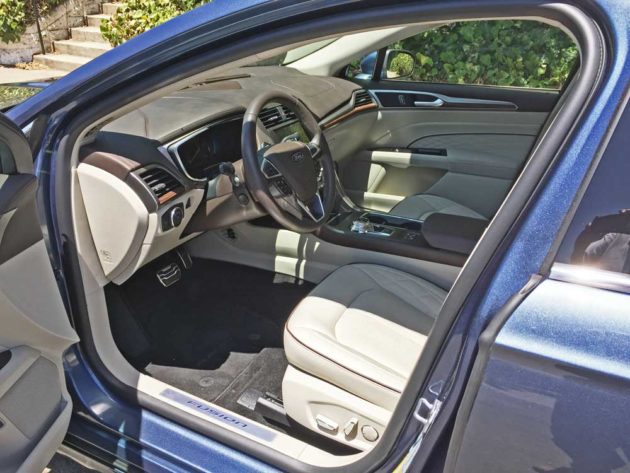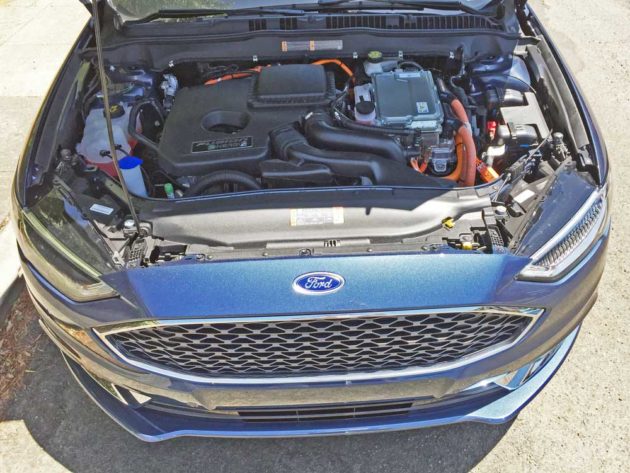?2018 Ford Fusion Energi Platinum?
Refreshed Fusion Energi adds Plush Platinum Trim

The Ford Fusion Energi Hybrid has been one of the top-rated plug-in hybrids available. That could very possibly change as more and more manufacturers are turning out entries in this market segment.
There is a non plug-in electric Fusion Hybrid available as well as a Ford Fusion Energi PHEV available. Additionally available are non-hybrid Fusions.
Overview
Last year, Ford refreshed the Fusion Energi with an exterior facelift along with several significant interior upgrades, and the addition of a more upscale Platinum model for consumers who are ecologically minded, but who also want to enjoy upgraded luxurious feature amenities.
In terms of the exterior modifications, all members of the Fusion stable display more of a Ford image with fewer Aston Martin-like cues.
There are LED headlamps and taillamps, the front fascia features a wider, more angular grille, chrome garnishes and LED fog lamps. The rear fascia and lower decklid are enhanced as well. The Platinum edition Energi Interior upgrades include a restyled center console featuring a rotary-type gear selector and repositioned cupholders with more space for a longer armrest and improved open storage area access in the lower dash. Ford?s improved Sync 3 infotainment system with navigation comes standard on Energi models.


Consumers who select the more expensive Platinum model get Medium Soft Ceramic toned, leather seats with contrasting antiqued Cocoa piping and matte finish wood trim accents.
Power Source
The front-wheel drive power source of the Ford Fusion Energi remains the same with a 118-hp electric motor working in conjunction with a 141-hp 2.0-liter Atkinson-cycle four-cylinder gas engine that puts out a total of 188 horsepower. The Fusion Energi can be propelled at speeds up to 85 mph on electricity alone. The Energi?s EV mode allows the driver to limit the gas engine?s operation to only extreme power demands, as passing scenarios or in ascending steep hills.

A 7.6-kWh lithium-ion battery pack continues to provide the energy for the electric motive force, drawing its charge while underway from a second motor/generator driven by the engine and from the regenerative braking system.
An external electrical source handles recharging duty when plugged into the charging port. The Energi provides a larger battery pack, over the conventional non-plug-in Fusion hybrid. EPA ratings for the 2017 Fusion Energi when using both gasoline and electric power are 95 MPGe city, 81 MPGe highway, and 88 MPGe combined. For drivers who are able plug in often and who commute only short distances in a reserved fashion can enjoy incredibly impressive fuel economy. If never plugging in, the Energi simply becomes a 42-mpg hybrid, that?s no more efficient than its standard and lighter weight hybrid sibling that offers the same EPA combined rating. The Fusion Energi is able to travel 22 miles exclusively on electricity, unlike the regular hybrid. The external charge port features an LED-illuminated state-of-charge indicator.
Visually, the five passenger Ford Fusion Energi is considerably more attractive and appealing than many of its competitors, projecting a sleek, aerodynamic profile, with the upward sloping hood flowing into the sharply raked windshield, which continues over the gracefully curved cabin into the flowing rear window that culminates with the short deck and its integrated spoiler lip. All of the Fusion Energi?s lines suggest rapid forward motion, even when parked.
My 2018 Ford Fusion Energi Platinum edition Plug-in Hybrid came, with a Blue metallic exterior finish and a Medium Soft Ceramic interior featuring Cocoa piping and trim accents. The base sticker was set at $41,305., while the final total came to $41,100. after factoring in the Destination and Delivery charge and significant Energi discounts.
Performance
The Ford Fusion Energi Plug-in Hybrid provides a pleasantly smooth and quiet ride quality in its electric mode when driven in a responsible and sensible manner, Tipping the scale at nearly two tons, the combined 188 horsepower in its hybrid mode is not dragster-like, and is even slower in it?s pure electric mode. But blasting over the road surface at break-neck speed isn’t part of the Fusion Energi?s mission statement.


When the gasoline engine kicks in, it is a seamless transition. Tires are the low-rolling-resistance variety and place the emphasis on fuel economy rather than grip, so racetrack maneuvers are likely to trigger chirps or squalls, and possibly an intervention from the stability-control system. Braking seems on the sensitive side of the equation at slower speeds, but familiarity takes care of the issue. Another approach is to select the Low Gear setting.

The 2018 Ford Fusion Energi commands a higher price than it?s non-plug-in hybrid sibling, but local, regional and national EV incentives are available to significantly reduce the price tag, bringing the cost more in line with non-hybrid stablemates.

The Hybrid and plug-in hybrid playing field is rapidly becoming more crowded, with several new players entering the game. The Fusion hybrid lineup isn?t necessarily the most efficient, nor do the models offer the most cargo space, but they do look good (and better than many) and they drive well, delivering the latest in safety features, infotainment and connectivity technology.
Ourautoexpert?s Take
In the final analysis, The 2018 Ford Fusion Energi Platinum turns out to be an attractive, practical and acceptably efficient mode of transportation in a reasonable price range.
SPECIFICATIONS: 2018 Ford Fusion Energi Platinum
Base Price: $41,305.
Price as Tested: $43,100.
Less $2,000. Fusion Energi Discount = $41,100
Engine Type and Size: 2.0-liter ?DOHC, 16-valve Atkinson Cycle inline 4-cylinder Energi plug-in hybrid electric vehicle with ECVT auto Trans powersplit.
Horsepower (bhp): 141 @ 6,006 rpm
Torque (ft./ lbs.): 129 @ 4,000 rpm
Electric Motor: 88kW Permanent Magnet AC Synchronous motor, 7.6 kWh Lithium-Ion battery with 35 kW Battery Peak Power. Total combined system horsepower=188 (195 in VCharge-Depletion Mode)
Transmission: Electronically controlled -CVT.
Drive Train: Transversely mounted front engine and motor/ Front-wheel drive.
Suspension: Four-wheel, independent
Front – MacPherson strut Short/Long arm design with stabilizer bar.
Rear ? Independent Multi-link with twin-tube, gas-pressurized shocks.
Brakes: Power-assisted four-wheel discs with ABS, Advance Trac? with ESC and Regenerative Braking.
Tires: Michelin X Green A/S 225/45 R18 mounted on 10-?V?-spoke, machine face, with anthracite painted alloy wheels.
Wheelbase: 112.2 inches
Length Overall: 191.8 inches
Width: 72.9 inches
Height: 58.0 inches
Curb Weight: 3,986 lbs.
Turning Circle: 18 ft. 8?
Fuel Capacity: 14.0 gallons
EPA Mileage Estimates: 43 mpg city / 41 mpg highway 104 city / 91 highway MPGe / EV Range=21 miles / Total Range=610 / Projected Electric Mode=85 mph
Drag Coefficient: Not listed.
0 – 60 mph: Not tested.
 Arv Voss is a Northern California based freelance motoring Journalist and member and past officer of several noted Automotive Journalist organizations who contributes regularly to a number of national and international media outlets. He reviews not only cars, trucks and SUVs, but motorcycles and unusual wheeled vehicles as well.
Arv Voss is a Northern California based freelance motoring Journalist and member and past officer of several noted Automotive Journalist organizations who contributes regularly to a number of national and international media outlets. He reviews not only cars, trucks and SUVs, but motorcycles and unusual wheeled vehicles as well.










